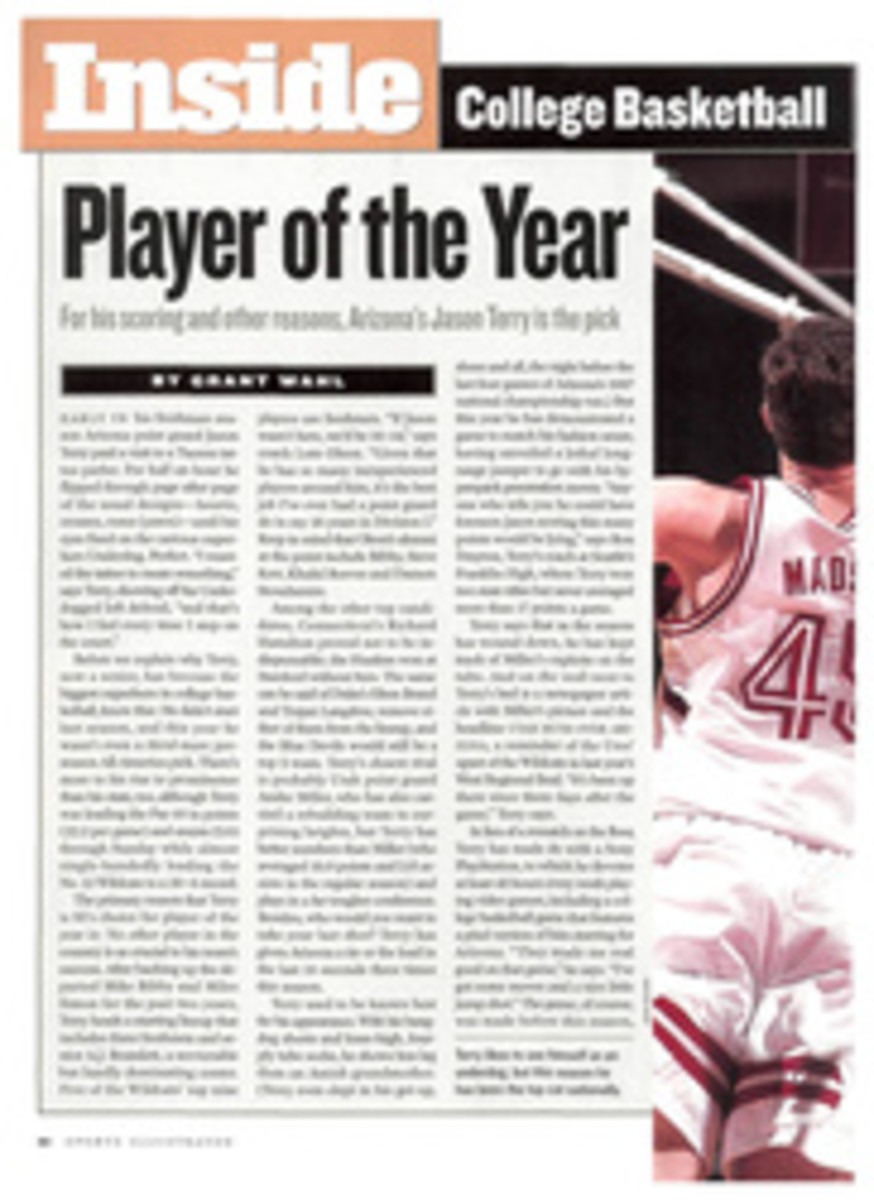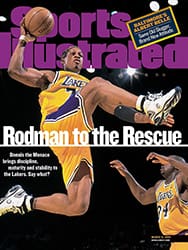
Soaring Ambitions A snake-loving vaulter charmed fans at the indoor nationals in Atlanta
In the loosely knit conglomeration of events that is track and
field, the pole vault has always stood out for the personalities
of the men--and now the women--it has attracted. They have been
eccentrics, daredevils, free spirits and, in some cases,
downright wackos such as Dave Volz, who used to dive 55 feet off
the catwalks in the Indiana field house to a tiny landing pit
below. It takes some rare quality to hang upside down from a
wildly bending pole and let it fling you 19 feet in the air.
After all, poles sometimes shatter, vaulters sometimes miss the
pit. On the family tree of athletes, vaulters swing from their
own cracked branch.
Jeff Hartwig is a handsome, clean-cut man who disavows any link
to this nutty species. But as he speaks, the stories begin to
slip out: How at Northern Iowa's UniDome, where Hartwig went for
a meet during his college days, there's a 35-foot-high wall next
to the vaulting pit, and, well, what would you do? "We had five
of us Arkansas State vaulters up there all aiming to land in the
pit at the same time," he recalls. Then there's the not-so-small
matter of Hartwig's snakes, 42 of them in all, boas and pythons,
some as long as 14 feet, which he raises for fun and profit in
his house in Jonesboro, Ark. One, a Burmese python named Niki,
used to accompany Hartwig to practice and loll in the
steeplechase water-jump pit. Another, a 10 1/2-foot python named
John, slept on Hartwig's water bed, curling up under his pillow.
"I'd sleep right on him," says Hartwig. "He loved that warm
mattress. It's amazing how long snakes will sleep somewhere if
it's warm." Hey, Jeff, the snake's craving for warmth is not the
most amazing thing about that story.
What has been amazing of late has been Hartwig's excellence in
the vault. Last year he cleared 19 feet 22 times, including 13
meets in a row. Both of those figures broke records held by
history's greatest vaulter, Sergei Bubka, who set the world
record of 20'2" in 1993. (Last year Bubka, 35 and hampered by
injuries, fell out of the world rankings for the first time
since '83.) Hartwig also had the highest vault in the world last
year (a U.S. outdoor record of 19'8 1/2"), a distinction no
American had attained since '78. "He just keeps getting better,"
marvels Hartwig's coach, Earl Bell, who was himself an Olympic
vaulter. "If you'd asked me four years ago if I thought he could
ever jump as high as Bubka, I'd have said no. Now I believe he
can."
Last Saturday afternoon, at the USA Indoor Track & Field
Championships at the Georgia Dome in Atlanta, Hartwig cleared 19
feet for the sixth time in six meets this winter, ultimately
sailing over an American indoor record of 19'5" to beat a superb
field. For only the second time, four Americans topped 19 feet
in the same meet, led by Hartwig and Nick Hysong, who finished
second with a 19'2 1/4". "With Nick and Lawrence [Johnson, who
placed third] jumping so well, I knew it was possible to jump 19
feet and not make the team," said Hartwig, referring to the fact
that only the top two finishers in each event in Atlanta
qualified for the U.S. squad headed to next week's world
championships in Maebashi, Japan. "I now feel I'd have to screw
up not to jump 19 feet, but I try to have respect for how high
that is."
Hartwig had plenty of time to learn respect. In high school he
didn't clear 15 feet, and in college he didn't reach 18. At 31,
he's a classic late bloomer, hanging in there through years
longer and leaner than any pole. In 1991 Hartwig earned just
$12,000--the salary Bell paid him to help out at the vaulting
school Bell runs in Jonesboro. Having had to beg his way into
meets just a few years ago, Hartwig now savors his new clout and
the six-figure income it brought him last year. He and his wife,
Karol, are building a new house with all the amenities, even a
600-square-foot snake room with running water in the cages.
With his chiseled good looks, athleticism and unforgettable
hobby, Hartwig is just the sort of athlete track and field needs
as it tries to win new fans. The crowd in Atlanta, announced at
9,810, was larger than in recent years, but with the exception
of the homestretch grandstands, the cavernous Georgia Dome felt
empty. The meet, however, was full. In addition to the vault
heroics, the fans were treated to an American record of 20.32 in
the men's 200 meters by Rohsaan Griffin and to a trio of
stunning upsets. In the men's 60, Maurice Greene, the world's
top-ranked sprinter, came within .01 of his world record in
winning his semifinal in 6.40 but got a poor start in the final
and finished second to Tim Harden, 6.44 to 6.49. John Godina,
No. 1 in the world in the shot put, and Charles Austin, the 1996
Olympic champion in the high jump, both finished third. In the
shot Andy Bloom threw 68'3 3/4" to win, while Henry Patterson
took the high jump with a leap of 7'6 1/2".
Atlanta was the culmination of the new four-meet Golden Spike
Tour. Two of the meets were carried live on network television
and two were broadcast on tape delay. That's progress in
regaining a place for the sport in the public eye, and USA Track
& Field CEO Craig Masback also points to the fact that he has
boosted the organization's sponsorship revenue from $1.3 million
in 1997, the year he took over, to $7 million in '99. Masback
wants to make some fundamental changes, too. For years now,
first as a 3:52 miler in the late '70s and early '80s and then
as a television track commentator, he has been filing away ideas
on how to streamline meets. "We need to organize our
presentation, choreograph it," he says. "In the old days it was
considered good to be a three-ring circus. I never understood
that. When I went to the circus, the bears didn't compete with
the elephants."
Some of Masback's changes have been obvious (sending out press
releases and results by E-mail), some less so (clearing the
infield of the detritus that track meets seem to accumulate). At
the D.C. Invitational in Fairfax, Va., on Feb. 19, a section of
stands was reserved for children, who had their own cheerleader.
Borrowing an idea from European meets, the women high jumpers
were asked to choose music to introduce their jumps. Another
innovation was a two-woman match race final in the dash. Still,
in a sport laden with tradition, not everyone is happy with
innovation. "We don't have to become roller derby," complained
one meet promoter.
"Most of [Masback's] detractors are people who've staked out
their teeny chunk of territory and want to defend it," says
Garry Hill, editor of Track & Field News. "I don't agree with
everything Craig has done, but I agree with his goal: Something
needs to be done. We've lost a generation of fans. Where is the
next generation going to come from?"
That's a good question, and one that 800-meter specialist
Meredith Rainey Valmon seems to be addressing on a couple of
fronts. Nineteen months ago she gave birth to a son, Travis. She
believes the experience has made her a better runner. "It taught
me the difference between what I want to do and what I need to
do," says Valmon, "and that made me get more serious about my
training."
Running in freezing weather this winter in the Washington, D.C.,
area, where she lives with Travis and her husband, Andrew
Valmon, a 1992 Olympic 4x400-relay gold medalist, made her
tough. Smart she has always been. In Atlanta, when she learned
she'd drawn lane 1 for the final, she made a point of getting
out fast rather than getting boxed in. Leading from the gun, she
passed 400 in 58.36 and then pulled away powerfully over the
last 100 meters to beat the runner-up, Michelle Ave, by seven
meters, in 2:00.55. "If I can do two-flat running in front all
the way I should run much faster in Japan," she said.
"Meredith has the itch that hasn't been sufficiently scratched
yet. That's what keeps smart athletes like her coming back,"
says former Stanford women's coach Brooks Johnson, who has
worked with Valmon. "The problem with athletes like that is they
have so many options that they can get distracted. They know
it's not the end of the world if they don't win. What Meredith
has to do is become more monomaniacal."
That won't be easy for Valmon. A quietly intense honors graduate
of Harvard, she has spent most of her 30 years dreaming about
all the things she would still like to experience. She longs,
for instance, to learn to play the beautiful old piano that
belonged to her jazz musician grandfather and now sits in her
living room in Silver Spring, Md.
Growing up in the tough Crown Heights section of Brooklyn,
Meredith was a tiny track dynamo, a star member of the Atoms
Track Club and a champion at the prestigious Colgate Women's
Games. But she has always had a mind of her own, and at 12 she
gave up running to devote herself to singing, dancing,
volleyball and basketball. She had no intention of returning to
track, but at Harvard her afternoons felt empty. "Besides," she
says, "I wanted to lose weight." In 1989 she won the NCAA 800
title in Provo, Utah, and then raced to catch the red-eye back
to New York, where she was to begin a summer internship the
following morning at a law firm.
"I expect a lot from myself," says Valmon simply. Travis takes
up most of her time these days, so she must schedule her
activities cunningly. Driving to and from the track each day,
she listens to French language tapes. But don't conclude she's
self-absorbed. In 1993 she and Andrew, who now serves as her
coach, founded a youth organization called the Avenue Program.
It uses D.C.-area Olympians to teach disadvantaged youngsters,
through clinics, essay contests and mentoring, that they have a
broad range of options. Along with the two Valmons, participants
include Alonzo Babers, the '84 Olympic 400 gold medalist who's
now a commercial pilot, and Ron Freeman, who ran the fastest leg
on America's '68 Olympics 4x400 team and now works in
fund-raising for universities. "Athletes get us in the door,"
says Andrew, "but we have doctors, lawyers and poets,
too--anyone who's a role model."
Certainly that includes Meredith, who seems to be doing a fine
job of schooling the next generation of runners, in her clinics
and at home. "I'm not sure Travis would be able to run straight
from point to point," she says, laughing, "but I'd put him up
against just about any other 19-month-old in the country."
COLOR PHOTO: BILL FRAKES Hartwig cleared 19 feet for the sixth time this winter, sailing over a U.S.-record 19'5".
COLOR PHOTO: BILL FRAKES MOMMY TRACK New mother Valmon, refocused on her sport, ran smart to win the 800.
"We've lost a whole generation of fans," says Hill. "Where is
the next generation going to come from?"

